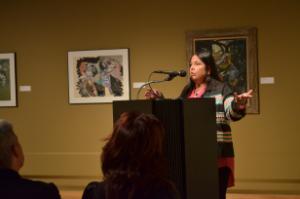 |
| Tina Osceola addresses the audience at the grand reopening of the Barton Wing at the Lowe Art Museum |
Native American artists have created beautiful and powerful works of art for millennia. “It’s the voice of the people who are no longer here to tell us their story,” said Osceola, noting that what a museum collects determines the story that will be recorded. Although many objects were created with utilitarian uses, they still embody a craftsmanship equal to that of objects used in sacred ceremonies. A prime example of this attention to detail is the Woman’s Patchwork Skirt, which represents a style that has become emblematic for the Seminole Tribe. Aside from the group of Seminole objects, the Barton Wing also includes Navajo, Apache, Zuni, Hopi, Pueblo, Haida, Kwakwaka’wakw, Tlingit, Aleut, Inuit, Cheyenne, and Lakota works, as well as objects from other ancient cultures.
“It is equally important to collect contemporary art like Erica’s [Deitz],” said Osceola, former director of the Ah-Tha-Thi-Ki Seminole Indian Museum, stating that not all Native American art is historical. The collection at the Lowe displays works of historical importance as well as that of prominent contemporary artists. Seminole Village I, 2008, by Erica Marie Deitz, was a recent museum purchase acquired specifically for display in the reopened wing. The painting depicts a village scene with a woman in patchwork holding a child in the foreground.
Osceola also noted the role of Seminole women in the tribe, “taking care of the village was one of the most honorable positions you can have.” As a child, she said that growing up in her household was very different then what she experienced in western society. She cited the importance of quilting, remembering how the generations of women sat together to quilt and how the conversations over this activity helped to develop the story that tells us who we are.
The new Barton Wing installation, curated by Traci Ardren, Associate Professor and Chair, Department of Anthropology, College of Arts & Sciences, features 115 of the most important and moving pieces from the Lowe’s permanent collection including works by notable contemporary artists such as Calvin Hunt, Preston Singletary, Beau Dick, Maria Martinez, and Erica Deitz – along with historic ceramics, textiles, metalwork, beadwork, and paintings, organized by geographical area as well as around the common themes of gender, music, beauty, and transformation.
The Art of the Native Americas in the Barton will be on permanent view at the Lowe Art Museum. The Lowe Art Museum is located on the campus of the University of Miami at 1301 Stanford Drive, Coral Gables. Museum gallery and store hours are Tuesday-Saturday, 10 a.m.–4p.m. and Sunday, noon–4p.m. The Museum is closed Mondays and University holidays. General Admission (not including programs) is $10, senior citizens and non-UM students are $5, and free for Lowe members, UM students, faculty and staff, and children under 12.
For more information on the Lowe Art Museum, UM College of Arts & Sciences, please visit lowemuseum.org

